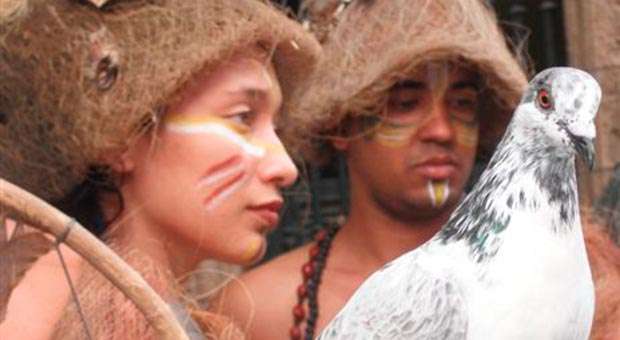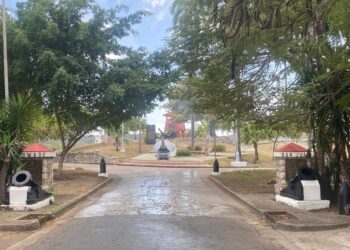A space crisis forces the Cuban theater group Gigantería to grow between limits and dangers. Its actors and musicians, sometimes walking and others on stilts, dressed in a style reminiscent of medieval minstrels, have spent 14 years performing in the streets of Havana’s historical center. The group retraces the city acting for the public, some may believe they come from some of the colonial castles, but never imagine the little room of four square meters where 18 artists store their flamboyant costumes and instruments, among other belongings.
“We have a crisis of space we need to pass to keep growing; we are the image of the big tree planted in a flowerpot, prevented from growing while without land. A tree with great potential contained by mud walls”, the group’s director, Roberto Salas, who likes to see himself as the elephant leader of a herd, living thanks to perseverance, says.
The wealth of the group comes in part from the various formations of its members; one is graduated from fine arts, other from percussion, and other-as Salas –from theater. Each brings initiatives from his branch and besides the studies; the director recognizes the value of self-education on years of experience on the street, in a theater way developed in constant interaction with the public.
According to the director , over three thousand public interventions have revealed the actors directions of work on themselves, their skills and abilities, the practice has been instrumental in their training process.
Gigantería attends parties and events with juggling, fire dances, living statues, performs plays and four times a week, they make the popular parade, always with live music.
The utensils: stilts, costumes, dolls, all made by the artists in the four walls of a small room located on the second floor of an apartment building on the corner of O’Reilly and Tacon Streets, in Havana. The group prides itself on being one of the first professional ensembles in Cuba, after the Revolution of 1959, lives 100 percent of self-management.
“We receive no state money for what we do and we have been recognized as a sustainable local experience, thanks to the emotional support of the Office of the City Historian. We live by what we do; we work and ask for money on the street. Possibly we are the first group in Cuba that has made it legally for 13 years, recognized by government authorities. It’s nothing new, it has been a natural phenomenon in every street artist in the world for centuries , but not in this country, and our 14 years of experience show success, as the project has not stopped growing artistically, “this graduate of the Higher Institute of Arts explained.
The support provided for years by workers of the Castle of the Royal Force, who let them rehearsing on the grounds of the former military fortress, has been invaluable. But the institution has its own schedules, the group can not train any time and creative processes have no agenda, Salas recalls.
“Many times we are forced to work in the 4 x 4 room, the same place where we preserve the material for the production, the patrimony generated in 13 years of uninterrupted work. And of course, with such crowding our equipment is spoiling because there is no place where to put the dolls, nor the costumes, despite this we continue rehearsing and currently we are dreaming of a new show, “he says.
That is the main limiting factor for the staging of more plays. While waiting for the grant of a venue, the group reinforces other expressive edges as road shows or parades which identify them in this part of the city.
According to Salas, juggling performances can be practiced anywhere, whether in small space of a house or on a roof, but that is not possible for training with stilts and musical instruments, due to specific complexities.
“We have generated more than three thousand public performances since this small little room and when we want to go to the bathroom we have to walk two blocks. We barely have space to accumulate more clothes, but it’s our meeting place, the place where we keep our project, all we have “he reaffirmed.
Gigantería has taken its art to other provinces of Cuba such as Isla de la Juventud, Pinar del Rio, Matanzas, Santiago, Granma, Holguin and countries like Italy and Ecuador and Salas, representing the ensemble, appeared in Mexico and the United States.
The group belongs to the catalog of Caricato artistic performances agency and has participated in numerous cultural events next to musicians as Leo Brouwer and bands such Van Van and Interactivo.
The director draws up an album with notes and posters where there is any mention of the company. He says he just has to wait because he has knocked all possible doors looking for support to get a new headquarter . That dreamed space would be, in addition to a site of presentations, also a center for workshops with children to maintain alive a theatrical tradition of over a century and a half in Havana.
“Many children love to walk on stilts, for example, and sometimes they have surprised us when spontaneously joining our presentations in the streets. We know we are not the only ones, luckily since the late twentieth century throughout the country other projects began working with stilts and acting in public spaces. The group Andante Teatro performed in Granma province, Miron Cubano in Matanzas, D’Morón Teatro in Ciego de Ávila, Tropa Trapo was here in Havana and a group of cells joined together 14 years ago in April to give birth to Gigantería “he recalls.
This student of Vicente Revuelta says that Old Havana was fertile ground for street theater, so he is constantly rethinking how to dialogue with the city from theater proposals. Over time, among all the artists, they were discovering how combine colors, lines, shapes harmoniously. Perhaps the most complex makeup, by the level of elaboration, is that of the living statues, which, according to Salas, give a very peculiar touch of distinction to public space, and they were barely known in Cuba until recently.
“Ours is an irreplaceable experience, as it is the result of the life of a group of people,” the director, who sees himself as a critical eye in the process, states. “I’m not the playwright sitting alone contemplating what others do and evaluate it critically; I am part of the group as a connection” he adds.
Currently, Salas is responsible for the dramatic rewriting of a collective script for a play called Holy Land . The plot revolves around the idea of life as a magical journey towards death. “It’s really about traveling in and out. The meaning of the journey into the story of a family: a man, a woman and a girl that everyone wants to make different trips. From there, a game starts for viewers to take a decision from the staging about what they would like most: traveling outward or inward, “he says.
“The show tries to argue that what matters is not traveling elsewhere, but to open the door of the heart to all roads to in and out from it. You are the trip, anyone can be the trip, “the playwright notes.
The project is delayed in time due to the aforementioned limitations. The last major release of Gigantería occurred in 2007. “You may wonder how can a theater group long delay in producing, and the answer is here, in the conditions, the space crisis that limits the creative process, we have virtually not place to rehearse, produce and store,” Salas says.
They remain alive because of the love and euphoria that people have get them on the street for 14 years in a peculiar city from the cultural, social and historical point of view. “But certainly we need help because if not, we could disappear,” Salas says while helping a partner to decide how to put a giraffe doll inside a hand-made case to preserve it as long as possible.
Cover photo: Beatriz Reyes










